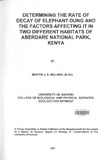| dc.description.abstract | Since the uplisting of the African elephant (Loxodonta africana) from appendix II
to appendix I of the Convention In Trade of Endangered Species (CITES), it has
become important to monitor their numbers and trends. Different survey
techniques are used for this purpose. In forests, conventional aerial counts of
elephants, as done in the African savannah can not be applied, and Barnes &
Jensen (1987) have since developed an indirect method of censusing forest
elephants. In this method, the density of elephant dung piles is used as an index
of elephant abundance, which is later used to estimate elephant numbers by
multiplying it with a correction factor. The correction factor in this case is the ratio
of the quantity of dung that disappears from the environment through decay to
the quantity of dung produced per elephant per day. In this study, the more
robust model for estimating forest elephants indirectly as proposed by Dawson
(1990) was adopted. This study aimed at; i) determining the rate of dung decay
in the bamboo and the shrub habitats of Aberdare National Park, (ii) identify the
climatic, environmental and biological factors that influence the rate of dung
decay and determine how they differ between the two habitats, and (iii) estimate
elephant densities and numbers in these two habitats of the Park.
Dung decay was measured by marking fresh dung piles and monitoring them (at
an interval of approximately seven to ten days) until they disappeared. A total of
two hundred and thirty one fresh dung piles were marked in the two habitats and
monitored until they disappeared. There was a significant seasonal difference of
dung decay rate in the Bamboo habitat. In the Shrub habitat, the seasonal
difference of dung decay rate was not significant. In the dry season, dung
decayed faster in the shrub habitat compared to the bamboo habitat. Dung
beetles and termites were observed to be the major decomposers dominating
the wet and dry season respectively. Jt was also observed that in the wet
season, minimum temperature and total rainfall had a positive effect on the dung
decay rate while in the dry season, the decay rate was affected positively by
maximum temperature, minimum humidity, and total rainfall but negatively by
minimum temperature.
The perpendicular distance model of the line transect sampling Method
(Burnham, et ai, 1980) and the Fourier Series estimator was used to estimate
the dung density. In wet season the shrub habitat registered the highest mean
dung density. Since the rate of elephant defecation was not estimated for these
habitats, the defecation rate estimated by Wing and Buss (1970) was used in the
equation for the model of estimating forest elephants. Both habitats showed a
high elephant density. However, the density in the shrub habitat did not change
much with season as compared to the bamboo habitat which showed a wet
season elephant density that was one and a half times greater than its' dry
season density. The number of elephants in the two habitats was estimated to
be 1,085 in wet season and 900 in dry season. | en |

